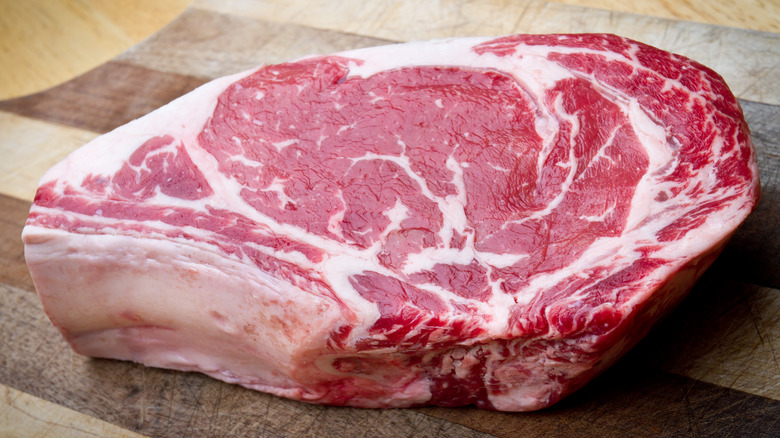What The Gristle On Your Steak Actually Is
With so many cuts of beef to choose from, knowing which ones are the most tender, lean, and have the least amount of gristle is essential knowledge in the kitchen. But, hold it; what exactly is gristle? All muscles have attached some kind of tissue connecting them to something else in the body, whether that's other muscles, bones, or tendons. Gristle is little more than the tough rubbery remnants that didn't manage to get trimmed away before the steaks hit your cutting board. These tissues are made up of collagen and elastin, each of which contributes to the texture of the cut. When cooked, collagen will break down into gelatin, like with a tender osso bucco, which makes the meat juicy and gives it an unctuous texture. Elastin, however, does not break down when cooked and grows tough; that's what we refer to as gristle.
The cuts with the most gristle are muscles that get the most exercise, like top round and chuck, which come from the higher leg muscles or the shoulder and rump regions. These muscle groups have a high proportion of collagen and elastin relative to interior cuts. These non-bone adjacent cuts tend to have less gristle because they are more easily cut away, although they can have some tough areas around the outsides. In contrast, steaks like tenderloin, or filet mignon have very little gristle.
How to manage the tougher cuts of beef
There are two ways to manage the tougher parts of meat, slow and low moist cooking for the cuts that have more collagen, and by cutting it off for the tougher elastin (also known as silverskin). One great example of a collagen-laden cut of beef is brisket. If you tried to grill brisket like a steak, the collagen would toughen up and make the result chewy and stringy. But by cooking slowly in a smoker or braising pot, the collagen melts and makes the wonderful taste and texture brisket is known for. On the other hand, beef shank is tightly covered in elastin. The sheets of tissue must either be cut off or the shank sliced into smaller sections to overcome the intense chewiness. Flank steak also has a great deal of connective tissue so after it's grilled, we cut it against the grain, which cuts through the elastin, making it easier to chew.
While gristle can be cut away from meat, it can also be consumed. Connective tissues are rich in amino acids that our bodies can use. In fact, the gristle that makes steak chewy is a very important part of nutritious bone broth! If you end up with a steak that has gristle, don't throw it away — trim it off and freeze it to simmer with extra bones and veggie scraps to make your own homemade broth.

